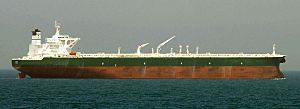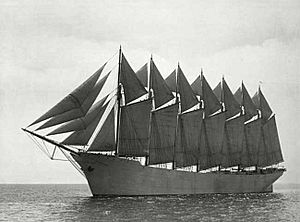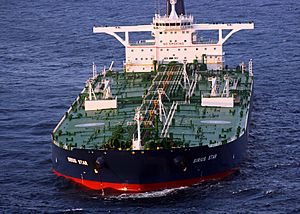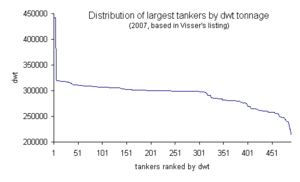Tanker (ship) facts for kids
A tanker is a special kind of ship built to move or store large amounts of liquids or gases. Think of them as giant floating containers! The main types of tankers are oil tankers, chemical tankers, and gas carriers. Tankers also carry other things like vegetable oils, molasses, and even wine. In some navies, a tanker that refuels other ships is called an oiler. Tankers first appeared in the late 1800s when new ways to build strong metal ships and pump liquids were invented. By 2005, there were over 4,000 tankers and supertankers around the world.
Contents
What is a Tanker Ship?
Tankers come in many sizes. Some are small, carrying a few hundred tons for short trips to coastal towns. Others are enormous, moving hundreds of thousands of tons across oceans. Besides ocean-going tankers, there are also special tankers for rivers and canals. These can carry a few thousand tons of cargo.
Tankers carry a wide variety of products, including:
- Oil and gas products like oil, liquefied petroleum gas (LPG), and liquefied natural gas (LNG).
- Chemicals such as ammonia and chlorine.
- Fresh water.
- Wine.
- Molasses.
- Fruit juice.
Tankers are a fairly new idea in shipping, starting in the late 1800s. Before that, ships weren't designed to carry huge amounts of liquid. Also, people didn't usually buy or sell liquids in such large quantities. Most ships carried many different items in separate storage areas. Liquids were usually stored in wooden barrels. This is where the word "tonnage" comes from, meaning how many barrels of wine a ship could carry. Even drinking water for the crew was kept in barrels.
Carrying liquids in bulk on older ships had several problems:
- Leaky Holds: Old wooden ships weren't sealed well enough to stop liquids from leaking or spoiling. Stronger iron and steel hulls fixed this problem.
- Loading and Unloading: Moving bulk liquids needs pumps. The invention of powerful pumps and pipes was key to creating tankers. Steam engines powered these early pumps. Special facilities were also needed on land to handle such large amounts of liquid. Barrels could be unloaded with simple cranes.
- Stability Issues: A large amount of liquid moving inside a ship can make it unstable, especially if the liquid sloshes around. This could even cause a ship to tip over! This problem was solved by dividing the large tanks into many smaller sections.
The oil industry was the first to widely use tankers. They moved refined fuel from factories to customers. This fuel was then stored in big tanks on land and divided for delivery. Other liquids also became cheaper to transport in bulk. Even the famous Guinness brewery used tankers to move their stout beer across the Irish Sea.
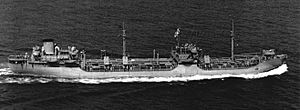
Different products need different ways of handling and transport. This led to special tankers like "chemical tankers" for dangerous chemicals, "oil tankers" for oil, and "LNG carriers" for liquefied natural gas. Some tankers can carry only one product, while others can carry several different chemicals or oil products at the same time.
Among oil tankers, supertankers are designed to carry huge amounts of oil, often from the Middle East around the Horn of Africa. The supertanker Seawise Giant, which was taken apart in 2010, was an amazing 458 meters (1,503 ft) long and 69 meters (226 ft) wide. Supertankers are one of the main ways to move large amounts of oil, along with pipeline transport and trains.
Thanks to stricter rules, tankers now cause far fewer environmental problems from oil spills than they did in the 1970s. For example, in 1979, there were 92 incidents that spilled 636,000 tons of oil. By 2020, this dropped to only 1,000 tons from three incidents, a huge improvement!
How Tankers Are Designed
Many modern tankers are built for a specific type of cargo and a specific travel route. The ship's draft (how deep it sits in the water) is often limited by the depth of the water in harbors where it loads and unloads. It can also be limited by the depth of straits or canals along its path.
Some cargoes, like certain gases, have high vapor pressure. This means they might need special pressurized tanks or systems to capture their vapors. Tankers carrying thick liquids like heavy crude oil, fuel oil, asphalt, wax, or molasses might need heaters. These heaters keep the cargo warm and liquid so it can be easily pumped out.
Tanker Sizes and Capacity
Tankers that carry liquid fuels are grouped by how much they can hold.
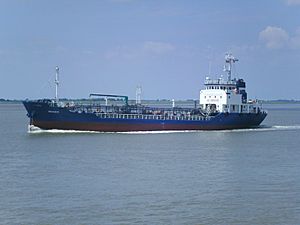

In 1954, a system called AFRA (average freight rate assessment) was created to classify tankers by size. At first, there were three main groups:
- General Purpose: Tankers under 25,000 tons deadweight (DWT) tons.
- Medium Range: Ships between 25,000 and 45,000 DWT tons.
- Large Range: Ships bigger than 45,000 DWT tons (later called Long Range).
As ships grew much larger in the 1970s, the list was expanded. Here are some of the main categories today, based on DWT (how much weight a ship can carry, including cargo, fuel, and supplies):
- Small tanker: 10,000–24,999 DWT DWT
- Medium Range 1 (MR1): 35,000–44,999 DWT
- Medium Range 2 (MR2): 45,000–54,999 DWT DWT
- Long Range 1 (LR1): 55,000–79,999 DWT DWT
- Long Range 2 (LR2): 80,000–159,999 DWT DWT
- Very Large Crude Carrier (VLCC): 160,000–319,999 DWT DWT
- Ultra Large Crude Carrier (ULCC): 320,000–549,999 DWT DWT
The most common large tankers are VLCCs, especially those between 279,000 t DWT and 320,000 t DWT DWT. There are nearly 380 vessels in this size range. Only a few tankers are larger than this, and about 90 are slightly smaller VLCCs.
Tanker Fleets Around the World
As of 2005, there were 4,024 tankers worldwide that could carry 10,000 LT DWT tons or more. More than half of these (2,582) were double-hulled, meaning they have two layers of protection to prevent spills.
Flag States: The country where a ship is registered is called its flag state. Panama is the top flag state for tankers, with 592 registered ships. Other countries with many registered tankers include Liberia (520), The Marshall Islands (323), Greece (233), Singapore (274), and The Bahamas (215).
Largest Owners: Greece, Japan, and the United States own the most tankers, even if those ships are registered in other countries. Greece owns 733 tankers, Japan owns 394, and the United States owns 311. Together, these three countries own over 36% of the world's tanker fleet.
Ship Builders: Companies in Asia build most of the world's tankers. Over 70% of the 4,024 tankers were built in South Korea, Japan, and China.
See Also
 In Spanish: Buque cisterna para niños
In Spanish: Buque cisterna para niños
- Hydrogen tanker
- List of gas carriers
- List of tankers


